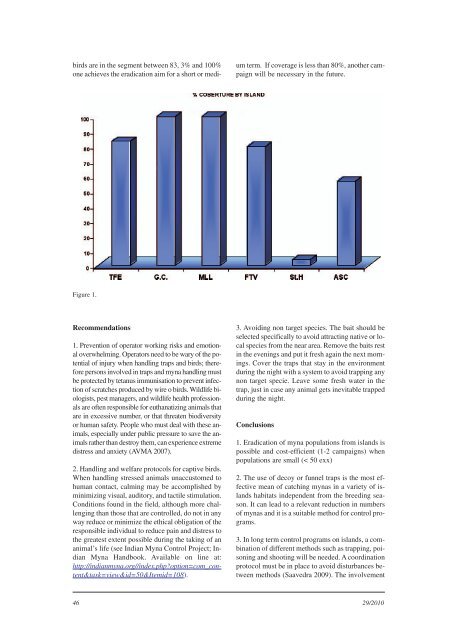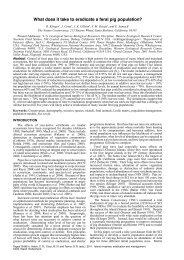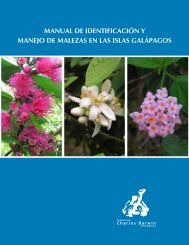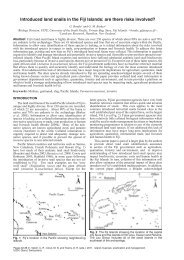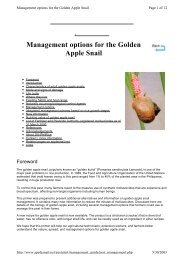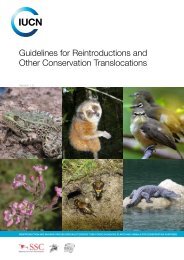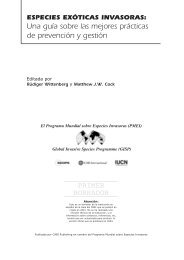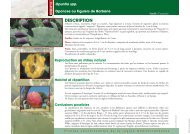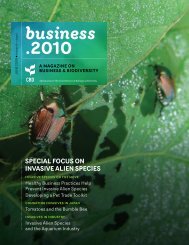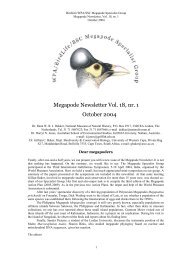Aliens Newsletter - ISSG
Aliens Newsletter - ISSG
Aliens Newsletter - ISSG
Create successful ePaper yourself
Turn your PDF publications into a flip-book with our unique Google optimized e-Paper software.
irds are in the segment between 83, 3% and 100%<br />
one achieves the eradication aim for a short or medi-<br />
Figure 1.<br />
Recommendations<br />
1. Prevention of operator working risks and emotional<br />
overwhelming. Operators need to be wary of the potential<br />
of injury when handling traps and birds; therefore<br />
persons involved in traps and myna handling must<br />
be protected by tetanus immunisation to prevent infection<br />
of scratches produced by wire o birds. Wildlife biologists,<br />
pest managers, and wildlife health professionals<br />
are often responsible for euthanatizing animals that<br />
are in excessive number, or that threaten biodiversity<br />
or human safety. People who must deal with these animals,<br />
especially under public pressure to save the animals<br />
rather than destroy them, can experience extreme<br />
distress and anxiety (AVMA 2007).<br />
2. Handling and welfare protocols for captive birds.<br />
When handling stressed animals unaccustomed to<br />
human contact, calming may be accomplished by<br />
minimizing visual, auditory, and tactile stimulation.<br />
Conditions found in the field, although more challenging<br />
than those that are controlled, do not in any<br />
way reduce or minimize the ethical obligation of the<br />
responsible individual to reduce pain and distress to<br />
the greatest extent possible during the taking of an<br />
animal’s life (see Indian Myna Control Project; Indian<br />
Myna Handbook. Available on line at:<br />
http://indianmyna.org//index.php?option=com_content&task=view&id=50&Itemid=108).<br />
um term. If coverage is less than 80%, another campaign<br />
will be necessary in the future.<br />
3. Avoiding non target species. The bait should be<br />
selected specifically to avoid attracting native or local<br />
species from the near area. Remove the baits rest<br />
in the evenings and put it fresh again the next mornings.<br />
Cover the traps that stay in the environment<br />
during the night with a system to avoid trapping any<br />
non target specie. Leave some fresh water in the<br />
trap, just in case any animal gets inevitable trapped<br />
during the night.<br />
Conclusions<br />
1. Eradication of myna populations from islands is<br />
possible and cost-efficient (1-2 campaigns) when<br />
populations are small (< 50 exx)<br />
2. The use of decoy or funnel traps is the most effective<br />
mean of catching mynas in a variety of islands<br />
habitats independent from the breeding season.<br />
It can lead to a relevant reduction in numbers<br />
of mynas and it is a suitable method for control programs.<br />
3. In long term control programs on islands, a combination<br />
of different methods such as trapping, poisoning<br />
and shooting will be needed. A coordination<br />
protocol must be in place to avoid disturbances between<br />
methods (Saavedra 2009). The involvement<br />
46 29/2010


